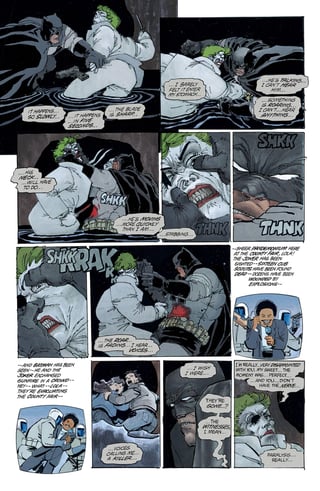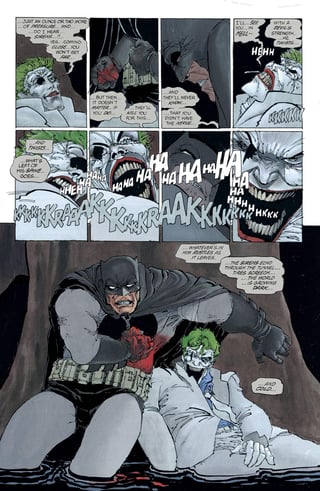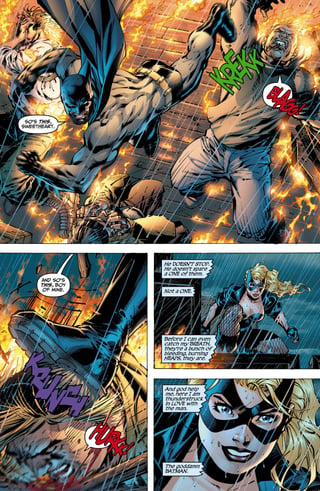This is potentially a very complicated question to deal with, due to the fact the continuity of the main DC universe comics has been rebooted multiple times, meaning that there have been different versions of Batman (from different realities) that were the main comics version of the character at different points in time.
The short answer to your question though is that the "Frank Miller Batman" you mentioned exists in an alternate reality, separate from the ones the main versions of Batman exist in.
In 1986, DC published a four-part miniseries written and drawn by Frank Miller, and titled Batman: The Dark Knight Returns. This story featured a version of Batman who was significantly older than the one appearing in the main Batman comics at the time. He had grey hair, and was somewhat past his prime, athletically speaking, but still capable of most of the same physical feats as the regular Batman, and posed a threat even to the Superman of his universe, due to his high intelligence, vast resources, and his tendency to plan ahead. He was also more ill-tempered
and cynical than the main version of Batman, and had no qualms about injuring criminals so severely that they might possibly be left permanently crippled.
POLICE OFFICER: You're under arrest, mister. You've crippled that man!
BATMAN: He's young. He'll probably walk again. But he'll stay scared -- won't you, punk?

Batman: The Dark Knight Returns #1 (June, 1986)
During an especially violent battle in Batman: The Dark Knight Returns #3 -- where Batman was seriously injured, and being repeatedly stabbed in the gut by the Joker -- he partially snapped the Joker's neck, as a means to paralyse him and end the fight. This didn't kill the Joker in and of itself, but the Joker wanted the authorities to believe Batman had killed him, so he deliberately laughed so hard that he fully snapped his neck and killed himself. When his body was later discovered by the police, they assumed Batman had killed him, and Batman subsequently became a fugitive from the law.
JOKER: I'm really... very disappointed with you, my sweet... the moment was... perfect... and you... didn't have the nerve... Paralysis... really... just an ounce or two more... of pressure... and... do I hear... sirens?... Yes... coming close... you won't get far... But then... it doesn't matter... if you do... They'll kill you for this... and they'll never know... that you didn't have the nerve...


Batman: The Dark Knight Returns #3 (August, 1986)
Around the time this miniseries was initially published, there was no official name for the reality the story was set in. However, in 1994, the same version of Batman appeared in an inter-company crossover issue with the Image Comics antihero, Spawn, and it was clearly stated on the credits page that the story was a companion piece to Batman: The Dark Knight Returns, and didn't represent current DC continuity.
Spawn Vs. Batman is a companion piece to DC Comic's The Dark Knight Returns. It does not represent current DC continuity.
Spawn/Batman #1 (April, 1994)
Batman didn't kill anyone in this crossover either, and clearly disapproved when Spawn casually killed a criminal in front of him.
SPAWN: You be careful, old man -- you be nice and sweet and careful. That woman's about to end everything and I'm stopping her and I don't care if it kills me all over again to do it.
BATMAN: No -- you fool -- she doesn't have to die!
SPAWN: Why not?

Spawn/Batman #1 (April, 1994)
At the end of story, Batman told Spawn that he found his "disrespect for human life" to be detestable, and that while he lacked the power to take him down now, he'd acquire the necessary power and then come after him in the future.
BATMAN: Your methods are revolting. Your disrespect for human life is detestable. Your lack of discipline is nothing short of embarrassing. We'll meet again.
SPAWN: You'd better hope we don't. I could have you for breakfast -- and if you step on my turf again, I will.
BATMAN: I don't have the power in hand to bring you down right now, boy -- but I'll get it -- and we'll meet again.

Spawn/Batman #1 (April, 1994)
In 2002, DC published a three-part miniseries written and drawn by Frank Miller, and titled Batman: The Dark Knight Strikes Again. This miniseries was clearly stated on the back covers to be a sequel to the earlier Batman: The Dark Knight Returns miniseries from 1986, and was set three years later, in-universe.
After fifteen years, the long wait for the sequel to The Dark Knight Returns is over! Frank Miller and Lynn Varley -- the multi-award-winning team responsible for the original series — have united once again to set up an astonishing new standard in comic book entertainment.
Batman: The Dark Knight Strikes Again #1 (February, 2002)
Again, Batman didn't directly kill anyone in this story. However, he congratulated Hawkman's son for having killed Lex Luthor, and it was implied that Batman had planned for that to happen.
LEX LUTHOR: It was you. You planned this. You knew he was coming. You knew what he could do. You knew. But you sat there. You let yourself get caught and sat there and took it. I punched you and punched you and you sat there and took it. Why?
BATMAN: To distract you. I have another operation in progress. Besides, I -- hell -- I just had to be here. To see that look on your face. It was worth it. Heads up. That window behind you is about to explode. And you're about to die.

The Dark Knight Strikes Again #3 (July, 2002)
During 2005-2008, DC published an ongoing series written by Frank Miller and drawn by Jim Lee, titled All Star Batman and Robin, the Boy Wonder. In the seventh issue of this series, Batman is shown to kill several armed criminals, setting them alight and beating them up whilst they burned to death. He also manoeuvred some of them into killing one another with friendly fire.
BLACK CANARY: He doesn't stop. He doesn't spare a one of them. Not a one. Before I can even catch my breath, they're a bunch of bleeding, burning heaps, they are. And God help me, here I am thunderstruck in love with the man. The goddamn Batman.

BATMAN: They're shooting scared. They're shooting stupid. Killing their own. Life is good.

All Star Batman and Robin, the Boy Wonder #7 (November, 2007)
The Batman featured in this series is much younger than the one shown in Batman: The Dark Knight Returns, but according to the artist, Jim Lee, the series is set in the same continuity as the earlier story, presumably serving as a prequel to it.
JIM LEE: Basically, I was doing All Star Batman and Robin with Frank Miller, and that came to a screeching halt when I was working on DC Universe Online, and then all the stuff with the co-publisher. That whole negotiation, or discussion, when that first started happening last fall. But I had a chance to sit down with Frank, after the announcement was made that I was co-publisher, and we figured out a gameplan. And basically, we've rebranded the title 'Dark Knight: Boy Wonder', 'cause it really doesn't fit in the All-Star universe. It's always been, really, from day one, an awkward fit. It's actually more in the Dark Knight Returns universe that Frank Miller created. And so Dark Knight: Boy Wonder will really tell the second half, the ending, to the first half that was told in All Star Batman and Robin.
JIM LEE Talks ALL-STAR BATMAN & ROBIN
In 2008, DC published a miniseries titled Countdown: Arena, which established that the Superman who appeared Batman: The Dark Knight Returns and Batman: The Dark Knight Strikes Again storylines was from a reality officially designated Earth-31. This is distinct from the current main DC universe, which is designated Prime-Earth. When the original Batman: The Dark Knight Returns miniseries was published in 1986, the main DC universe then was designated New Earth.
If you'd like me to expand more on the differences and relationships between Prime-Earth and New Earth, and the other realities that have served as the main DC universe at one time or another, feel free to post a separate question about that. The bottom line though is that the "Frank Miller Batman" you mentioned exists his own reality, separate from all of those.
As an addition note, in 1987, Frank Miller also wrote and drew a four-part storyline titled "Batman: Year One", which appeared in Batman Vol. 1 #404-407. The served as a new origin story for the main comics Batman of the time, the New Earth Batman. However, from what I've been reading online, it's apparently also considered to be an origin story for the Earth-31 Batman.








